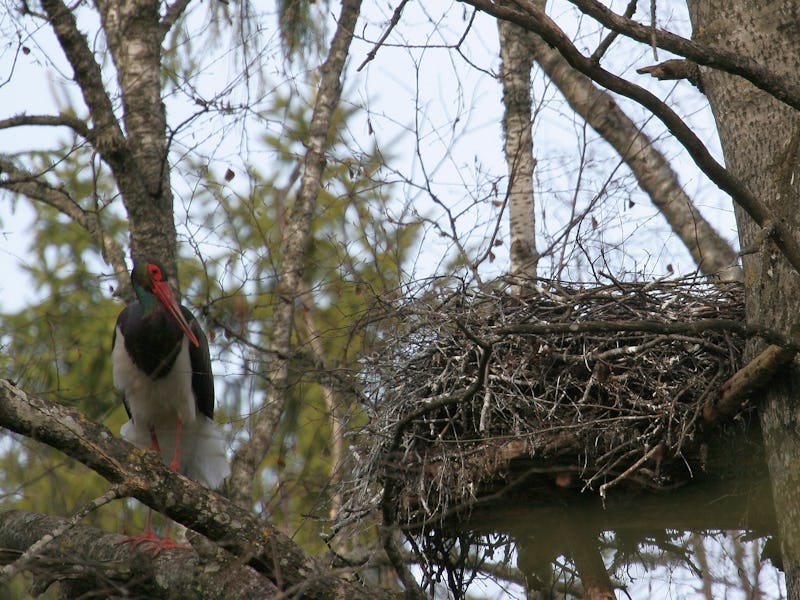Extremely Sad Birds Show How a Population Can Die From Loneliness
"Waiting for a partner. Often in vain."

Black storks in Estonia are experiencing a situation all single people have lived through: Taking stock of your life and realizing that you’re completely, utterly alone. Unlike lonely millennials, these monogamous birds don’t have the option of swiping right for a last-ditch hookup, which is deeply unfortunate. As new research on this threatened species indicates, it could be possible for an entire population to die from loneliness.
Bird watchers in Estonia had noticed for years that some populations of the elegant black storks, with their spindly red legs and pointed beaks, have been declining for a long time, but nobody was sure whether it was predators, changing climate, or another factor altogether.
"…waiting for a partner. Often in vain.
“The reasons behind these declines are unknown but identifying these are of utmost conservation importance,” write the authors of the study in the ornithology journal Ornis Fennica, published Tuesday. But by investigating the various factors affecting the reproductive success of one population living at the northern reaches of stork territory, the team discovered that the bird species is declining because many of the birds have no one to mate with.
The single life is especially bleak for some black storks.
Returning from their winter migration, male storks scramble to repair their nests to win the hearts of incoming females, but sometimes all that effort ends up wasted. Ülo Väli, Ph.D., a researcher with the Estonian Environment Agency and corresponding author of the article, snapped the photo below and summed up the situation in its caption: “Black stork at the nest waiting for a partner. Often in vain.”
Black storks wait around for their forever partner, but sometimes nobody shows up.
Installing automated cameras at over 20 known nesting sites in Estonia and snapping nearly 450,000 photos between 2010 and 2015, the team discovered that 35 percent of nests were occupied by “single, non-reproductive birds.”
These sad singles, the researchers write, might be responsible for the mysterious decline of the population. In the 41 different breeding territories they tracked, they found that the productivity (the ability to make babies) was low compared to populations in nearby Latvia and Lithuania, at only 1.1 fledgling chicks per occupied nest. And in total, only 37 percent of occupied nests managed to produce a chick.
"One third of nests are occupied by single birds.
“Indeed, our most striking result is that currently about one third of nests are occupied by single birds, and this explains the low proportion of (successfully) breeding territories at the distributional margin,” the team writes.
The question lonely individuals can’t help but ask is: Why am I single? The most plausible reason for all those single storks, the team writes, is that there’s an unbalanced sex ratio in the population — likely too many single males compared to females. This hypothesis is consistent with how some of the frustrated singles were acting: harassing neighboring couples at their nests. (It’s hard to get a clear answer about sex ratios, however, because in this species, both sexes look the same.)
There doesn’t appear to be any biological reason why this population has more males than females, so one possible explanation for this skewed sex ratio is that the females, perhaps fed up with sub-par living conditions, looked to breed in a different region. A more tragic possibility is that they died during migration.
No matter what the reason for all the single storks in this population, one thing is becoming increasingly clear: It’s slim pickings for birds looking to mate, and if only 37 percent of nests are producing fledglings, it doesn’t look like things are going to get better anytime soon. The team hopes the new data will help them design better breeding interventions for the birds, which will hopefully boost the population’s numbers and make life for all of them a little less lonely.
Abstract: Understanding the mechanisms forming species’ ranges is a central ecological question, which could be answered by analysing factors limiting peripheral populations. In threatened species, such studies are essential for establishing effective conservation measures across the range. We analysed factors potentially influencing breeding in a declining peripheral population of a long-lived bird, the Black Stork (Ciconia nigra). We assessed reproductive success and the effects of intra- and interspecific competition, as well as predation by recording events at nests by remote cameras (camera traps and a webcam). Productivity of storks was low (1.1 fledglings per occupied nest) compared to the other parts of the range and resulted mainly from the lower proportion of successful nests (37% of occupied nests). The main reason for low breeding success was the occupancy of many nests (35%) by single non-reproductive birds. Breeders were often visited by non-local conspecifics, which harassed local birds but only seldomly caused direct damage. Impact of predators and interspecific nest-competitors on reproductive success was low. We suggest that many individuals have disappeared from the breeding population and shortage of mates is currently the most important factor lowering reproductive success of the Black Stork at its northern range margin. This mechanism could also limit the peripheral abundance and distribution in other long-lived birds.